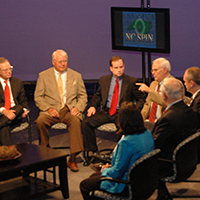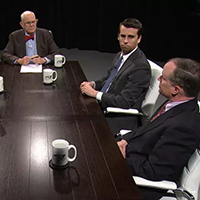Ballooning child care costs in America have become a hot topic of discussion across the country. The Women’s Bureau of the US Department of Labor has data available as recently as 2022, indicating that families in some parts of the country spend close to 30% of their income on infant child care costs. In Wake County, a family can expect to spend as much as 13.1% of their income on infant child care, while in Edgecombe County, families may spend as much as 18%.
Gov. Josh Stein announced the creation of a task force earlier this year to tackle this very issue. But what if we’re missing the point entirely?
Child care is a business with an economic impact of over $152 billion annually. And like any business, there are costs — employee salaries, utilities, facility maintenance, taxes, etc.
Lift the restrictions, regulations, and taxes in places that contribute to the downstream rise in child care costs, and you make child care more affordable. And we can probably do this without even touching a lot of the child care-specific regulatory measures in place to protect our children.
Federal and state subsidies for child care are undoubtedly the primary driving force behind the artificial rise in prices. Carolina Journal’s Donna King and Jeff Moore have both written about this within the last year.
Missouri-based child care center consultant, Business of Child Care, who does work in North Carolina, actually made it a point of pride to note that they helped a client raise prices so the center could take advantage of more government subsides. It’s worth noting that the facility referenced is a nonprofit child care provider.
John Locke Foundation vice president of research, Brian Balfour, summarizes the issue like this: “Low-income households who receive the subsidies don’t feel the pinch [from higher costs]. The rich are inconvenienced, but can afford it, and it’s the middle class that gets squeezed. They pay taxes that finance the subsidies but make too much money to enroll in the subsidy programs, so they are stuck both paying the taxes and the artificially increased child care costs.”
It’s a vicious cycle that we see in housing, healthcare, higher education, and any other time the government distorts market signals (supply and demand) that provide clear metrics for what people actually need and how much they’re willing and able to pay for it.
Low wages that contribute to staffing shortages in the child care sector are certainly a very real issue that drives up costs for providers, but it’s not the only sector that’s experiencing high labor shortages. A recent study focused on occupational licensing published by the John Locke Foundation found that North Carolina is experiencing a “more-severe” labor shortage as compared to the national average, with 55 workers for every 100 open jobs.
What I’d like to emphasize here is that wage growth is largely dependent on an employer’s ability to invest in its workforce. If an employer is forced to contend with increasingly cumbersome compliance costs, it’s no surprise that wages may be held at unsustainably low levels. Employers simply don’t have anywhere else to turn other than to raise prices.
Let’s move on to taxes. NC House Bill 115 wants to eliminate the state property tax for child care facilities to reduce their costs. I applaud the effort, but when you go down the rabbit hole of creating exceptions to existing law — especially tax law — it complicates the entire system. Compliance costs are a huge problem across the board. So, while I don’t hate HB 115, it’s not the only tax that needs examination.
For instance, the North Carolina Franchise Tax raises costs for businesses, chipping away at their bottom line and limiting their ability to raise wages or invest in growth — especially small businesses. Why? Because the tax is assessed on the net worth of the business, not its reported income. So even in a year where a company loses money, if their total net worth is at least $1 million, they pay a $200 tax. My colleague Joseph Harris lays it all out here. If this expense were gone, businesses across the state (including child care facilities) have one fewer financial burden to contend with.
Next, let’s look at the regulatory climate faced by child care providers. The Division of Child Development and Early Education of the North Carolina Department of Health and Human Services administers a “star rating system” as a way to signal the quality of child care among specific providers. Child care providers choose which star rating they want to achieve, and do the work to meet the required qualifications. You can read more about the process here.
I find it particularly interesting that a “family child-care home” (an in-home daycare) can earn additional points towards a higher star rating by reducing “the number of infants enrolled.” Why does the government think my infant child is any less cared for at an in-home daycare facility than at a larger center? This is precisely the sort of thing that Gov. Josh Stein’s task force needs to review.
Finally, let’s tackle energy and utility costs. Former Gov. Roy Cooper’s 2021 carbon reduction plan sought to reduce carbon emissions goals by 70% by 2030 and achieve complete carbon neutrality by 2050. Research published at the time by the John Locke Foundation estimated that meeting these goals would increase energy rates for North Carolinians by $411 annually. By July 2024, Duke Energy was reporting estimated increases of closer to $720 annually.
Child care centers pay these increased energy prices just like the rest of us, and it drives up costs for families.
Recent steps by the state legislature through HB 73 and SB 261 would eliminate the interim carbon reduction goals for 2030, staving off some of these rate increases, at least for the near term. Both bills have passed preliminary votes in their respective committees, but are still pending a full vote in both chambers.
We are certainly long overdue for a major adjustment to how we approach child care in America. But we are also our own worst enemy when it comes to simply making it easier to do business and live and work in a capitalist economy. When government interferes with the market signals of a particular sector, supply and demand are distorted. Child care is no different.







